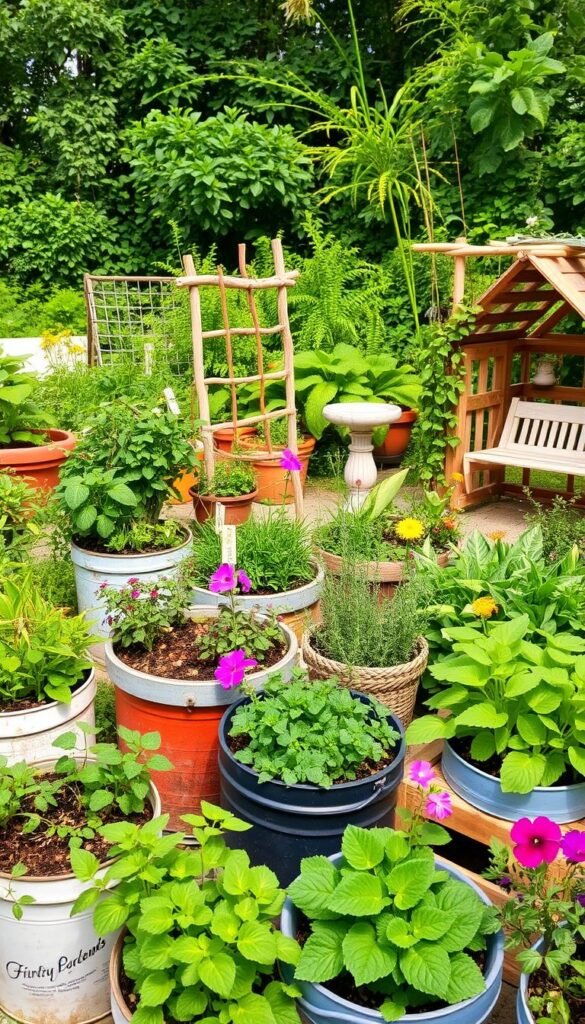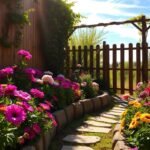Creating a beautiful garden doesn’t have to drain your wallet. With a little creativity, you can turn your outdoor space into a lush retreat without overspending. Small changes, like reusing materials or choosing budget-friendly plants, can make a big difference.
In this guide, you’ll discover 10 practical strategies to enhance your garden for under $20. From vertical setups to container hacks, these ideas work year-round. Many gardeners have successfully revamped their spaces using simple, cost-effective methods.
For example, building raised beds with repurposed wood can save you money while adding structure. Whether you’re a beginner or a seasoned grower, these tips will help you maximize your budget and enjoy a thriving garden.
1. Start with Smart Container Gardening
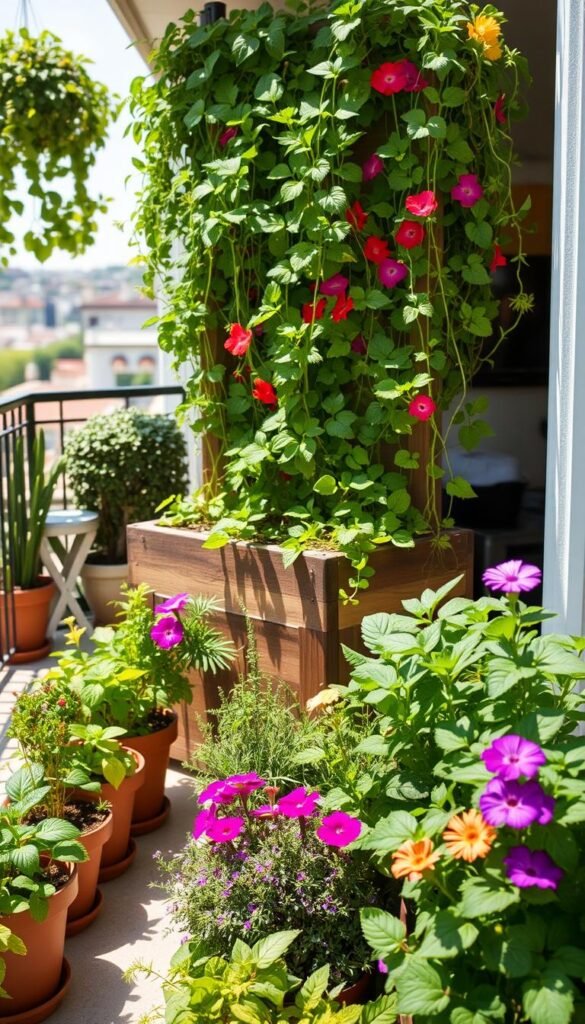
Turn everyday items into charming planters with simple tweaks. Containers don’t need to be expensive—think old boots, tin cans, or even colanders. With proper drainage and soil, these quirky designs add personality to your outdoor space.
Repurpose household items as planters
Rain boots with drainage holes make playful herb planters. Line them with gravel before adding soil to prevent rot. Thrifted teapots or plastic bottles work well for succulents, too.
For a mobile garden, hang colanders with chains. Their holes naturally drain excess water. Pair self-watering pots with moisture-loving mint or basil for fuss-free growth.
Choose drought-resistant plants for low-maintenance pots
Lavender and sedum thrive in poor soil, needing minimal care. Agave and yucca handle dry spells, perfect for sunny spots. Layer gravel at the base of pots to improve drainage.
Pre-planted hanging baskets from brands like Crocus offer instant color. Combine them with wall-mounted racks to save money while maximizing vertical space.
2. Budget-Friendly Home Gardening Ideas with Paint
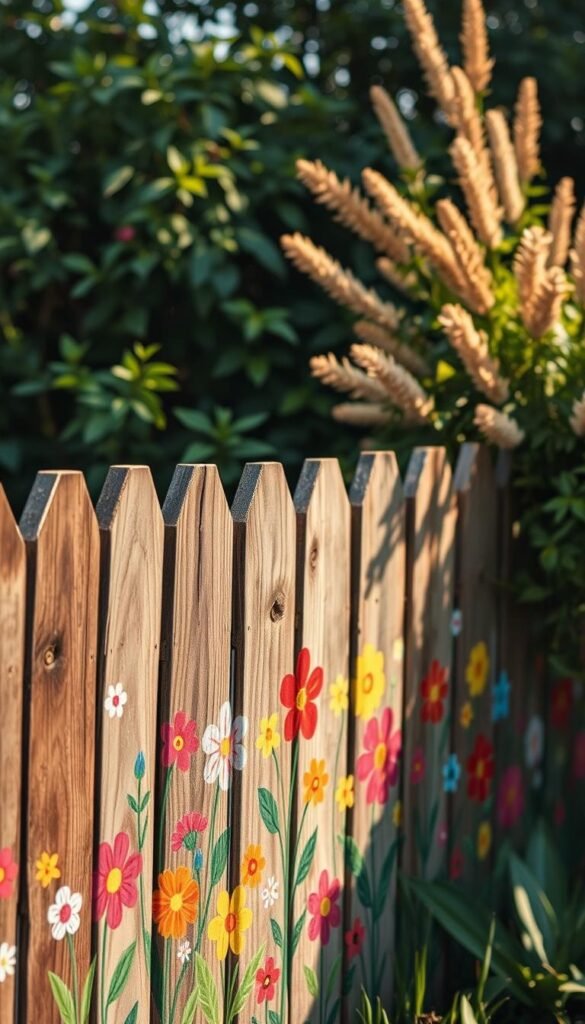
A fresh coat of paint can instantly elevate your outdoor space without costing a fortune. Whether refreshing a worn fence or repurposing old furniture, strategic color choices and durable materials make all the difference.
Transform fences and sheds with black paint
Dark hues like Cuprinol Ducksback Black create depth, making fences recede into the background. This trick expands small yards visually. For sheds, Frenchic paint lasts 4+ years, hiding flaws with rich cornflower blue or charcoal.
- Save money: Painting costs 80% less than replacing panels.
- Use matte finishes to blend structures into greenery.
- Pair black fences with bright planters for contrast.
Refresh old furniture for garden accents
Vicki Collis turned her shed into a chic bar using chalk paint. Try similar design hacks:
- Sand and spray-paint metal chairs with rust-resistant formulas.
- Convert ladders into tiered plant stands with pastel tones.
- Match planter colors to fences for a cohesive look.
Vintage style thrives with distressed finishes. A $10 thrifted table becomes a centerpiece with teal wax highlights.
3. Grow Vertical to Maximize Small Spaces
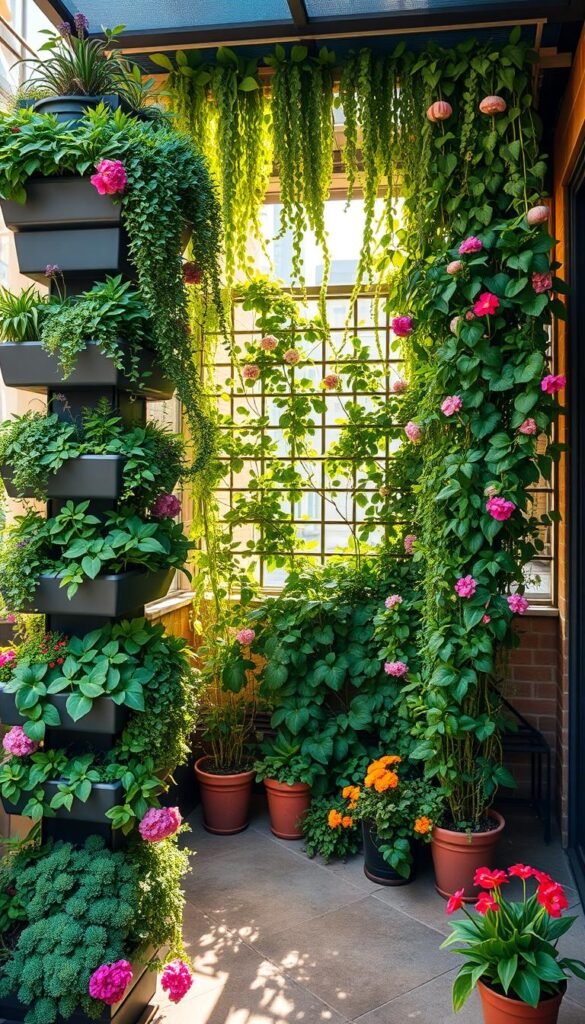
Small yards can bloom big with clever vertical solutions. By directing plants upward, you free up ground space for seating or pathways. Even balconies become lush with the right design.
Install wall-mounted plant racks
Elho’s Loft Urban Wall Rack (under $25) holds herbs or succulents neatly. For DIY flair, repurpose shutters as succulent displays. Pocket planters hung on railings maximize balcony space effortlessly.
- Convert old gutters into herb walls—drill drainage holes and mount horizontally.
- Use chicken wire panels for climbing strawberries or peas.
- Adam Dilley’s tip: Divide perennials like hostas to fill racks for free.
Train vines on repurposed trellises
Passionflower and jasmine quickly cover bicycle wheel trellises. Pallet gardens with drought-tolerant plants (like sedum) add texture. For quick coverage, clematis thrives on woven willow branches.
Pro tip: Paint trellises black to make greenery pop. This trick blends structures into your garden while highlighting vibrant blooms.
4. Propagate Plants for Free
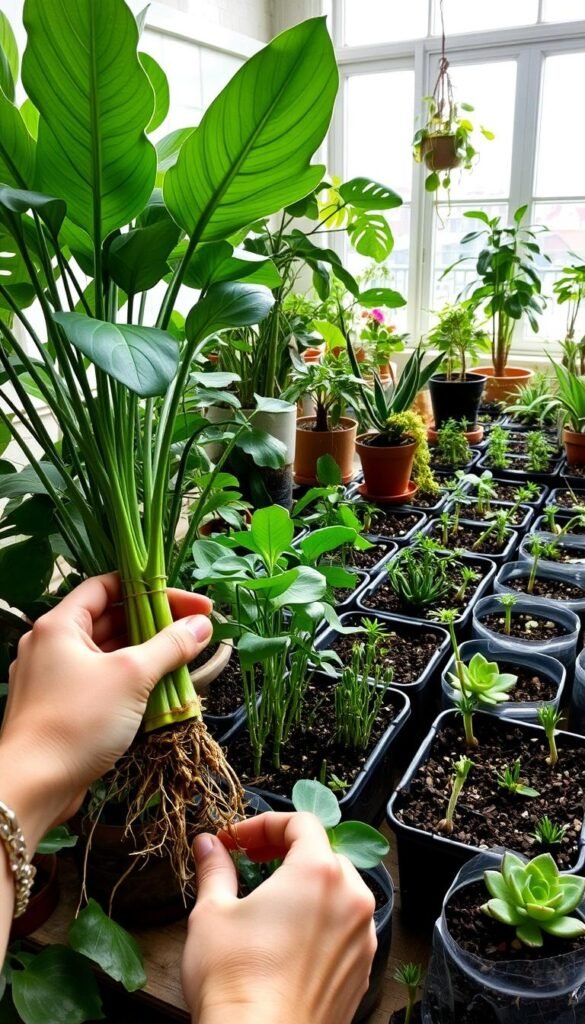
Multiply your favorite plants without spending a dime by mastering simple propagation tricks. From dividing perennials to rooting cuttings, these methods help you save money while expanding your garden.
Divide perennials like geraniums and hostas
Early spring is the best time to split overgrown clumps. Six divided geraniums can fill an average garden bed. Use a spade to separate astilbe or daylilies, ensuring each section has roots and shoots.
Hostas thrive when divided every 3–4 years. Replant clusters in shady spots or trade extras with neighbors. This preserves heirloom varieties and keeps your space lush on a budget.
Root cuttings in water before planting
Snip 4-inch stems from pothos or mint, leaving 2–3 leaves. Dip in willow water (steep willow twigs overnight) or rooting hormone for faster growth. Once roots appear, transfer to soil in takeout-container greenhouses.
- Swap cuttings through local gardening groups to diversify your collection.
- Use clear jars to monitor root progress without disturbing plants.
- Pair this method with DIY planters for a cohesive look.
5. Create DIY Garden Decor
Personalize your yard with handmade accents that reflect your creativity. From playful planters to outdoor movie nights, these projects use affordable *materials* to elevate your *outdoor space*. Best of all, most take less than an hour to assemble.
Turn Wellies into Quirky Planters
Old rain boots make charming herb planters. Drill 3–4 holes in the soles for drainage, then layer gravel and potting soil. Try pairing mismatched boots along a pathway for a whimsical *design*.
For a polished look, paint boots with outdoor-grade acrylic. Use stencils to add floral patterns or stripes. Herbs like thyme and oregano thrive in these compact *spaces*.
Build an Outdoor Cinema
Kel Harmer’s setup proves you don’t need expensive gear. Hang a king-size sheet between trees or patio umbrellas. Pair with an Amazon projector (under $90) for crisp visuals.
| Material | Cost | Use |
|---|---|---|
| White sheet | $12 | Screen |
| Fairy lights | $8 | Ambiance |
| Cinder blocks | $0 (repurposed) | Seating base |
Host themed nights: plant lavender nearby for a relaxing aroma during dramas. Use LED candles in mason jars to light walkways safely.
More Quick Decor Ideas:
- Convert cracked teacups into fairy gardens with moss and mini figurines.
- String silverware wind chimes using fishing line for a melodic touch.
- Arrange mosaic stepping stones with broken tile pieces and quick-set cement.
6. Save with Seed Starting
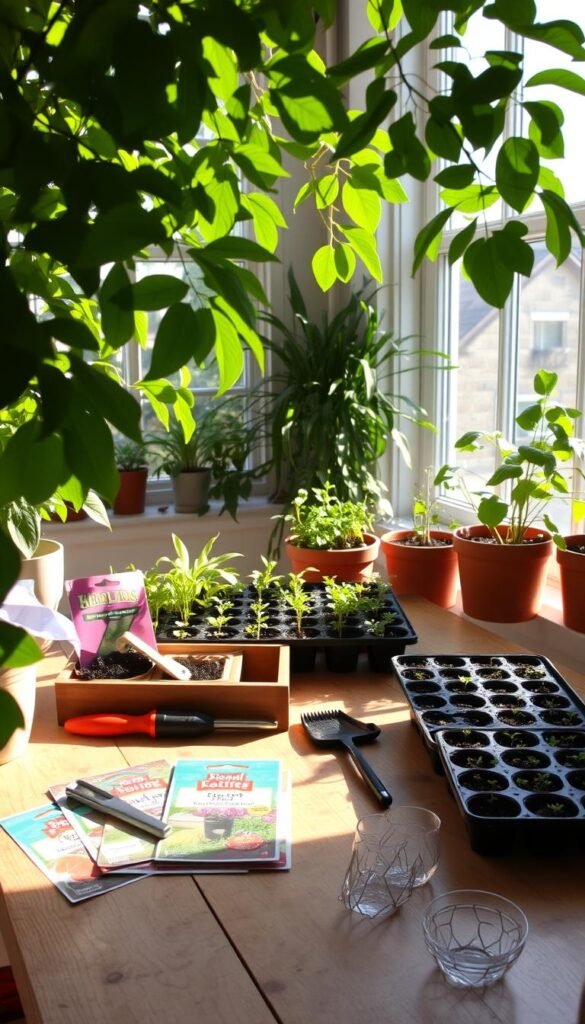
Kickstart your growing season without spending a fortune by mastering seed-saving techniques. A packet of seeds costs less than seedlings, and with a few tricks, you can turn trash into plant-ready pots. This method lets you grow dozens of plants for the price of one store-bought starter.
Make Biodegradable Pots from Toilet Paper Rolls
Cardboard tubes decompose naturally, making them perfect for seed starters. Cut rolls into 2-inch sections, fold one end to create a base, and fill with soil. Plant directly into your garden—no transplant shock!
- Save money by repurposing egg cartons for herbs like basil.
- Create seed tape with flour glue and newspaper strips for even spacing.
- Use clear salad containers as mini greenhouses to trap humidity.
Swap Seeds with Neighbors
Community swaps let you diversify your garden without a budget hit. Organize events or join local groups to trade heirloom varieties. Baker Creek Rare Seeds offers unique options for ambitious growers.
| Option | Cost per Plant | Success Rate |
|---|---|---|
| Store-bought seedlings | $3–$5 | 90% |
| Home-started seeds | $0.10–$0.50 | 75% (with care) |
Store extra seeds in labeled jars with silica gel packs to prevent moisture damage. For more dirt-cheap seed-starting methods, try newspaper pots or yogurt cup planters.
7. Upcycle for Practical Solutions
Transform trash into treasure with these budget-friendly garden upgrades. Repurpose household materials to solve common challenges, from labeling plants to conserving water. These projects cost little but deliver big results.
Wine Cork Plant Markers
Jack Sutcliffe’s hack turns corks into stylish labels. Slice them lengthwise, glue to bamboo skewers, and write plant names with waterproof ink. They’re durable and add rustic charm to herb pots or seed trays.
- Save money: Use leftover corks instead of buying markers.
- Paint them for color-coding different herb varieties.
- Push skewers deep into soil to withstand wind.
Plastic Bottle Drip Irrigation
Cut the bottom off a bottle, poke tiny holes near the cap, and bury it upside down near roots. This slowly releases water, reducing waste by 30%. Perfect for tomatoes or thirsty perennials.
| Method | Cost | Water Savings |
|---|---|---|
| Bottle irrigation | $0 (reused) | 25–30% |
| Soaker hose | $15–$20 | 20% |
More Upcycling Wins:
- Turn tetra packs into bird feeders—coat with peanut butter and seeds.
- Use soda bottles as cloches to protect seedlings from frost.
- Hang old CDs to scare birds away from berries.
8. Attract Wildlife on a Dime
Inviting nature into your yard doesn’t require expensive setups. With a few clever tricks, you can turn your outdoor space into a thriving habitat for birds, bees, and butterflies. These budget-friendly ideas enhance your garden’s biodiversity while adding charm.
DIY Tin Can Bird Feeders
Upcycle soup cans into cheerful feeders. Paint them with weatherproof acrylic, then fill with birdseed. Hang from tree branches using twine for a rustic design.
- Clean feeders weekly with vinegar to prevent mold.
- Mix seeds with peanut butter for extra energy.
- Place near shrubs to give birds shelter.
Pollinator-Friendly Planting
Choose native plants like echinacea and milkweed to support local ecosystems. These blooms attract bees and butterflies while needing minimal care.
- Cluster flowers in sunny areas for maximum visibility.
- Add a shallow dish with rocks for butterfly puddling.
- Avoid pesticides to keep pollinators safe.
More Wildlife Hacks:
- Stack bamboo stalks to create bee hotels.
- Turn broken pots into toad abodes—add damp moss inside.
- Make hummingbird nectar with 4 parts water to 1 part sugar.
9. Build Soil Naturally
Healthy soil is the foundation of a thriving garden. By composting kitchen scraps and repurposing materials, you create nutrient-rich dirt for pennies. These methods cut costs while boosting your plants’ health.
Start a compost pile with kitchen scraps
Layer brown (dry leaves) and green (vegetable peels) materials for fast decomposition. A 3-bin system made from pallets keeps piles organized. For small spaces, try worm towers—they fit on balconies.
- Add eggshells for calcium, ideal for tomatoes.
- Shred newspaper to aerate compost, helping root veggies.
- Turn piles weekly to speed up breakdown.
Leaf mold from autumn collections enriches soil naturally. Steep compost in water for a free nutrient boost—spray it directly on plants.
Use coffee grounds for acid-loving plants
Blueberries and hydrangeas thrive with coffee grounds’ slight acidity. Mix 1 cup into soil around their bases monthly. Avoid overuse—it can compact dirt.
| Plant Type | Coffee Grounds per Month |
|---|---|
| Azaleas | ½ cup |
| Roses | 1 cup |
Test pH with budget-friendly container gardening kits like Soil Savvy. For quick fixes, banana peels add potassium for blooms.
10. Invest Once, Harvest for Years
Smart choices today can fill your garden with bounty for seasons to come. Perennial plants like asparagus and artichokes keep producing with minimal effort. A single planting yields harvests for 5-15 years, helping you save money long-term.
Amelanchier trees offer four-season beauty—spring blooms, summer berries, and fiery fall leaves. For edible landscape options, try raspberry canes along fences or dwarf fruit trees in containers. Blueberries thrive in acidic soil, bearing fruit for decades.
Evergreen shrubs like boxwood add structure while rosemary cuttings root easily for endless herbs. Compared to annuals, these choices cut your budget by 60% over time. ShrubHub’s 70% off square-foot gardening kits make starting even easier.
Pair these with no-till beds for low-maintenance success. Your future self will thank you for these strategic investments.

